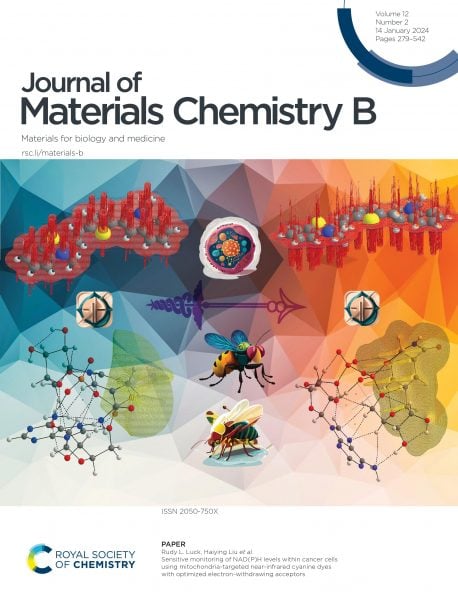
A team of dedicated researchers achieved a significant milestone in the field of cancer detection and monitoring. Their collaborative cancer research culminated in the publication of a paper in the prestigious Journal of Materials Chemistry B.
Collaboration Across Departments
The team was led by Ph.D. student Dilka Liyana Arachchige, alongside Research Scientist Sushil K. Dwivedi (Chem); undergraduate students May Waters, Sophia Jaeger, Joe Peters, Daniel R. Tucker and Micaela Geborkoff; and Professors Thomas Werner (Biological Sciences) and Rudy L. Luck and Haiying Liu (both Chemistry).
Their groundbreaking paper is titled “Sensitive monitoring of NAD(P)H levels within cancer cells using mitochondria-targeted near-infrared cyanine dyes with optimized electron-withdrawing acceptors.”
Cancer Research Featured on the Cover
Highlighted on the journal’s front cover, the research introduces two cutting-edge near-infrared cyanine dyes meticulously engineered for the precise detection of NAD(P)H, a critical biomarker in cancer metabolism. These dyes exhibit primary absorption peaks at 438 nm and 470 nm, transitioning seamlessly into fluorescence at 748 nm and 730 nm upon interaction with NAD(P)H, showcasing an unprecedented level of sensitivity. Notably, their unique design enables deep tissue penetration with minimal disruption, rendering them invaluable for non-invasive cancer detection and continuous monitoring.
Of particular significance is their efficacy in monitoring glycolysis-induced NAD(P)H levels within mitochondria, offering insights into cancer cell metabolism and the effects of chemotherapy drugs. This breakthrough promises to advance our understanding of cancer progression and enhance treatment strategies.
Key Funding Agencies Support Collaborative Cancer Research
The research, supported by the National Institute of General Medical Sciences and the National Institutes of Health under multiple award numbers, underscores the vital role of funding agencies in driving scientific innovation. Liu, expressing gratitude as a co-PI, acknowledges the National Science Foundation’s support for a new NMR spectrometer, emphasizing the collaborative effort across disciplines in pushing the boundaries of scientific discovery.
About the Chemistry Department at Michigan Technological University
Chemists at Michigan Technological University help students apply academic concepts to real-world issues and advance research making contributions to health and well-being, environmental protection, responsible use of materials, and climate stabilization. The Chemistry Department offers five undergraduate degrees, an MS and PhD in Chemistry, and an accelerated MS. Supercharge your chemistry skills to meet the demands of a technology-driven society at a flagship public research university powered by science, technology, engineering, and math. Graduate with the theoretical knowledge and practical experience needed to solve real-world problems and succeed in academia, research, and tomorrow’s high-tech business landscape.
Questions? Contact us at chemistry@mtu.edu. Follow all the latest happenings on the Chemistry Blog.
